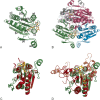WrbA bridges bacterial flavodoxins and eukaryotic NAD(P)H:quinone oxidoreductases
- PMID: 17893367
- PMCID: PMC2204128
- DOI: 10.1110/ps.073018907
WrbA bridges bacterial flavodoxins and eukaryotic NAD(P)H:quinone oxidoreductases
Abstract
The crystal structure of the flavodoxin-like protein WrbA with oxidized FMN bound reveals a close relationship to mammalian NAD(P)H:quinone oxidoreductase, Nqo1. Structural comparison of WrbA, flavodoxin, and Nqo1 indicates how the twisted open-sheet fold of flavodoxins is elaborated to form multimers that extend catalytic function from one-electron transfer between protein partners using FMN to two-electron reduction of xenobiotics using FAD. The structure suggests a novel physiological role for WrbA and Nqo1.
Figures


References
-
- Asher G., Dym, O., Tsvetkov, P., Adler, J., and Shaul, Y. 2006. The crystal structure of NAD(P)H:quinone oxidoreductase 1 in complex with its potent inhibitor dicoumarol. Biochemistry 45: 6372–6378. - PubMed
-
- Beyer R.E., Segura-Aguilar, J., DiBernardo, S., Cavazzoni, M., Fato, R., Fiorentini, D., Galli, M.C., Setti, M., Landi, L., and Lenaz, G. 1996. The role of DT-diaphorase in the maintenance of the reduced antioxidant form of coenzyme-Q in membrane systems. Proc. Natl. Acad. Sci. 93: 2528–2532. - PMC - PubMed
-
- Cadenas E. 1995. Antioxidant and prooxidant functions of DT-diaphorase in quinone metabolism. Biochem. Pharmacol. 49: 127–140. - PubMed
-
- Ernster L. 1987. DT-Diaphorase: A historical review. Chem. Scr. 27A: 1–13.
-
- Georgellis D., Kwon, O., and Lin, E.C. 2001. Quinones as the redox signal for the arc two-component system of bacteria. Science 292: 2314–2316. - PubMed
Publication types
MeSH terms
Substances
LinkOut - more resources
Full Text Sources
Molecular Biology Databases
Miscellaneous

